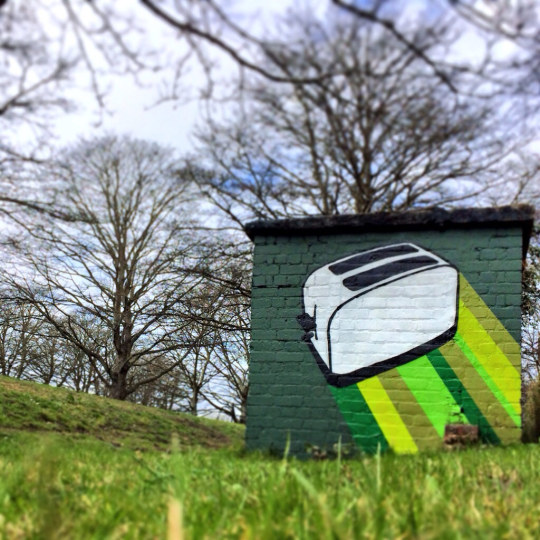
Interview in French of Tacos, Mouse from Bulgaria and myself at Noshimag.
Podcasts in Spanish with Nuria Mora, Ampparito and a few more at vdevictoria.
L’outsider
L’Outsider about his studio work. (German subtitles on Arte.fr)
The Art of Rebellion IV – interview
Christian Hundertmark aka C100 author of The Art of Rebellion books shared a few words with us 13 years after the 1st AOR book.
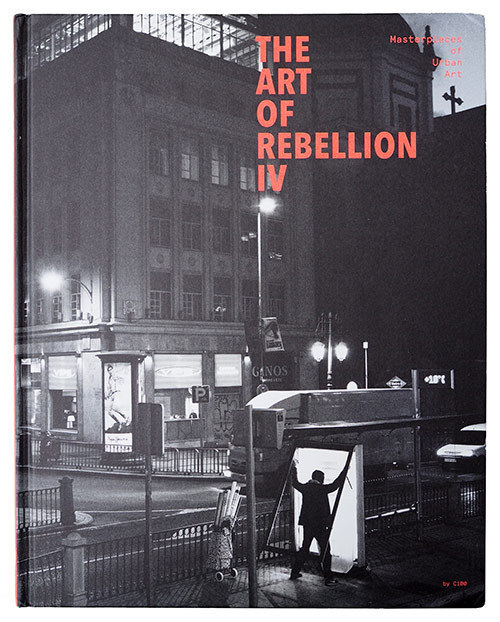
– When you wrote the 1st Art Of Rebellion in 2004, the goal was to
present that new post-hip-hop-graffiti scene also known as street-art.
What is “Art of Rebellion 4” about ?
In general it’s the same topic as the previous ones: introducing street art / graffiti to a wider audience. But this time with a new approach: Instead of just documenting / introducing the most interesting new works I asked each artist to select his most favorite work and write a short text why they had chosen the particular piece. This led to really interesting results which gives the reader a new insight on each artists work concept.

– According to you what are the biggest changes the urban-art scene have experienced last decade ?
In my personal humble opinion I’d say that street art made a very
successful step in terms of attracting recognition from people outside
the scene which had both positive and negative aspects. I mean nowadays everyone knows what street art is…! One one hand that’s a great development as many artists got the chance to step into the contemporary art world, doing big art shows in galleries and can make a good living out of it etc., which I think is nice as it proofs that this young art form got the respect it definitely deserved. On the other hand it got a bit predictable, some artists works got very hyped even though their work weren’t very inventive and more or less unambitious.The use of stereotypes seemed like there was a ultimate street art cook recipe: Some drips here, some sampling of pop art there, some punk attitude and there you have the street artist the audience expect to be the next Banksy…. which I think is a bit lame.Still in general I think the quality of the works made a huge step!
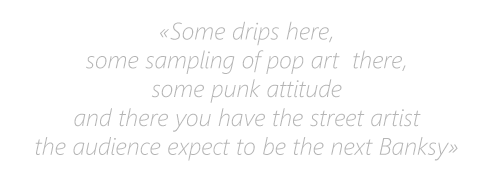
– When I compare the photos of the 1st AOR and the new one, what I notice is that nowadays many artworks are huge and legal. Nowadays the
urban-scene seems to be run mainly by professionals. Is the title “Art
of Rebellion” still accurate ? And has the street-art scene been really rebellious one day ?
Yes, this is a justified question and I think if it wasn’t a series considering another title would make sense :) but if you start form the basis each artist featured has street credibility and authenticity. Most of them still work in the streets illegally which could be contemplated as a rebellious act in a way, too. Still, I’m aware that „real" rebellion is connected to much more radical acting but I think the title is a great wordplay which makes totally sense in this context of art. Also I’d like to add that by asking the artists for their most favorite artwork they ever did anything would have been possible. And this is what happened in the end. This book is more like an opener for the viewer to get into the whole work portfolio of each featured artist. I.e. Honets feature (both photo & text), which is one of my favorites, it’s essential that you know both what his current works AND his background from day one. I’m really happy that this concept worked out so good.
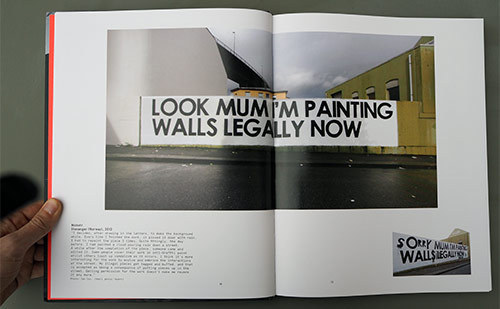
– In the book we can see people work that were in the previous books, but also new artists. Can you tell us a few names of people you discovered recently and enjoy the work ? (they don’t need to be in AOR4)
I discovered the work of Hayden Kays, Hot Tea, Maser and Mobstr during the process. Even though others maybe knew their works before I got into their art more or less by chance and I’m really happy to have them in the book!
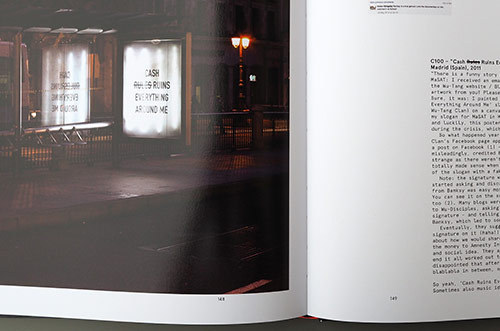
– Like many of us I like good punchlines and slogans written on walls or on stickers. Under your C100 alias, you did excellent “Cash rules ruins everything around me” posters. That was an instant-classic to me. But I
discovered in AOR4 that crazy story about the Wu-tang trying to sell
copies of your work claiming it was an original work from Banksy. Could you sum-up this unbelievable story ?
Haha, yes to say it in one sentence: Wutang tried to fool the internet by telling that „The Cash ruins everything around me“ poster was done by Banksy and selling it as a limited screen print for 100$ as a Wutang/Banksy collab – and I found out about it! As
everyone knows, if you have Banksy involved the attention and value of a print will rise exorbitantly and very fast hence it’s much easier to sell…. The problem was that someone send me the link to that post on the Wu Disciples Blog and I found out about this hoax. In the very beginning the screenprint also had a Banksy Logo on it! Unfortunately I didn’t make a screenshot of this. After a few emails back and forth with Wu Disciples manager we agreed to make a screenprints with the original artist (me) and donate the earned money to “Doctors without Borders” but even though I organised everything at one point I didn’t got any more replies and it came to nothing. Luckily the internet doesn’t forget, so did I :) and when working on the book I found almost all links that proof the truth of this unbelievable story.
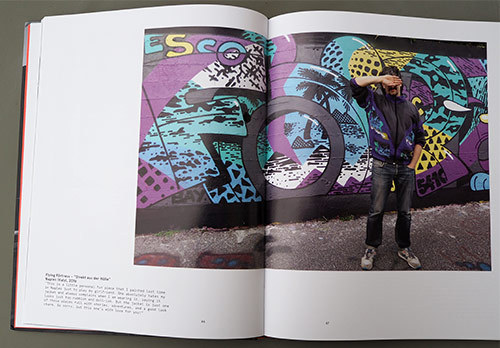
– Do you expect to do an “Art of Rebellion 5” one day ?
I think it’s the same answer like for the last 4 books: Maybe, …we’ll see what happens. But I can imagine that this can happen, for now I’m happy with the latest result :)
Thanks for the interview!
The Art of Rebellion #4
216 pages – English- ISBN: 978-3-939566-49-6
About 35€ – Available at Stylefile
ROWDY interview
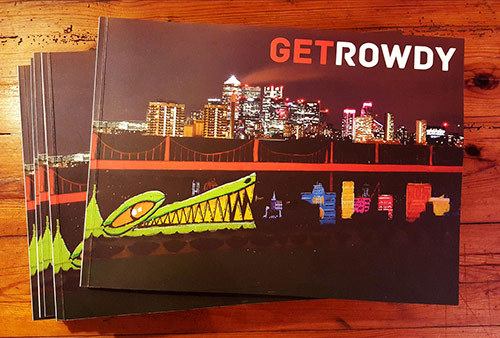
I took advantage of the release of Get Rowdy by Rowdy from Bristol to ask him a few questions about his book, his work and his city.
– Can you present yourself? How did it all begin?
Well attached is the 1st actual Rowdy piece I did in Bristol in 1992 taken from someone’s (graffarty) instagram . I had different tags from 87 up until this point.
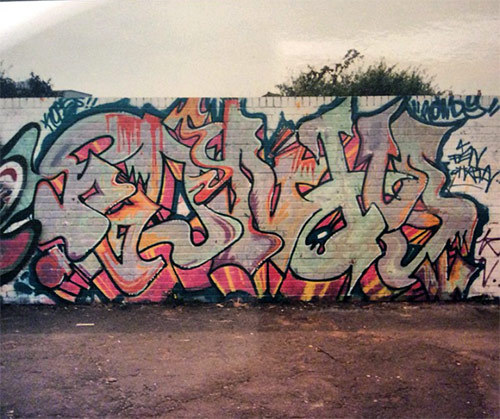
– Get Rowdy book is about your works from the last 7 years. You started in the late eighties. With such a long carrier, haven’t you been tempted to show your earlier works?
Of course it would be nice to show earlier work, much of which was actually destroyed due to a studio fire back in 2010. I was looking for narrative and wanted to show where my head is currently at, in terms of being a creative.

Has it been difficult to select the photos ?
It’s frustrating when you have done a cool piece and the photo’s don’t quite cut it. I think for this reason it was absolutely integral for the book to have Alex Ellison on board his work is mainly focused around London being the modern graffiti archivist he is very meticulous in his endeavors and captures a phenomenal amount of writers transient work and his night shots are stunning.
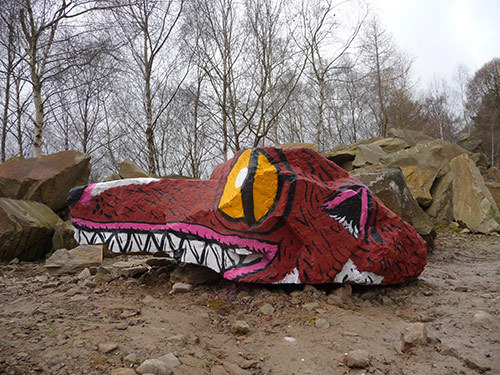
– Cats, rats and birds are popular animals on the walls. Do you remember how your obsession with crocodile started ?
Playing & painting in Quarries was the catalyst, dwelling in the underground space gets you thinking about creatures like fossils and crocodiles. Given the fact these vast clearances of the land pave the way for our roads and Cities helped me focus on the Ancient V Modern. Initially I decided to paint various creatures on some of the large remaining boulders one of the 1st being a Crocodile circa 2003. I went on to make several installations in different quarries during the mid naughties and not long after this I took the Croc to the streets.There were already cats like La Mano and Pez doing the logo bombing thing not to mention Keith Haring way back plus characters had always been a big part of my repertoire during my graff years. I just wanted to connect with a different audience whilst retaining a fairly hardcore graffiti aesthetic what’s more the quarry work wasn’t getting the attention of the usual graff watchers and I liked this, it was a great time as you know so much was happening and practitioners were pushing our beloved art form in all kinds of directions back then, and I didn’t feel to cynical about it as I do sometimes these days.
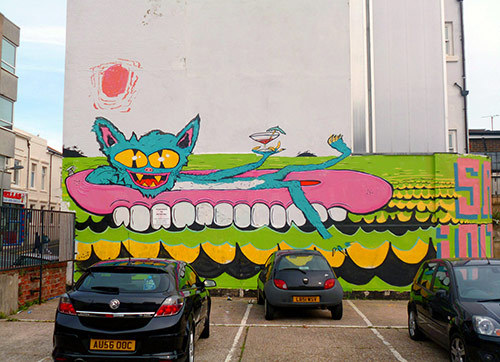
– You collaborate very often with friends like Sweet toof or Goldpeg. What do you like most, painting alone or with other people?
The shared experience of being wild and having fun is such a buzz. It helps set you free from the mental torment you have to endure on your own as an artist in say the studio or the business world. The crew helps validate each others work.On the other hand when alone there is the chance to really get in the zone see how far you can push things, this particularly applies to my abstract work.

– In the book you present some abstract works I didn’t know from you. This is really different than your graffiti work. Have you ever thought about painting such pieces outside?
On a couple of occasions this work has appeared outdoors and maybe I will revisit that idea again at some point ultimately I just wanted to keep something back for myself that couldn’t so easily be ripped,buffed or written over. To have some longevity in the contemporary art world as well as in peoples homes, slightly more conventional I guess but there again try being an abstract artist in Britain?
I’m also interested in some of the parallels between wildstyle graffiti and abstract art, many don’t like their street art too complicated so in a sense it provides a nice counter balance to my Croc work.
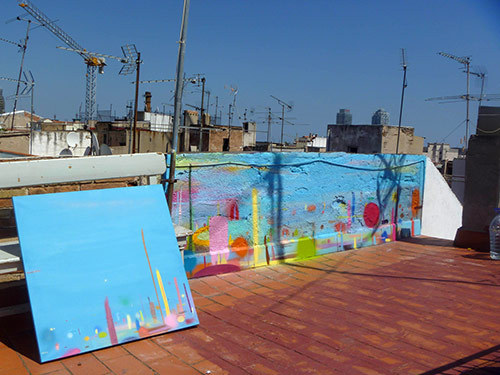
– Bristol graffiti scene has always been known worldwide thanks to 3D featured in Spray Can art book, and of course more recently because of Banksy.
According to you has all this attention to Bristol graffiti scene been a good thing ? (Little story, a colleague who has absolutely no particular interest in graffiti or graphic design went to Bristol last summer. He told me the best thing about his holidays was the Bristol street-art tour he paid…)
Bristol has a fantastic history and it’s a shame 3D’s pieces never got the same Banksy heritage status but how could they given the times, I guess for me that’s why the book is a form of preservation. Jon Nation who works on some of the tours is undoubtedly a recommendation as far as I’m concerned as he’s a proper Bristolian and been around for time and a big supporter to all concerned. So yeah I would suggest it’s well worth a visit and the pound is now weaker due to Brexit. There are types trying to regulate our scene having never come from an Art/ Graffiti background offering up walls that are looking some what watered down or trying to hard in their approach . Generally it’s a good mix here but as property prices rocket we need more Artist lead projects if we want credible art in the City and hope the vandals don’t get caught going about their activity.
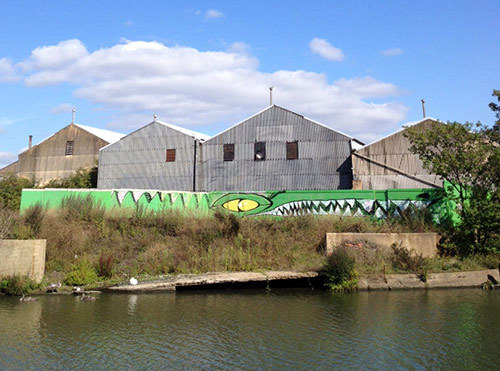
– If you could explore and paint anywhere in the world, where would you go and why?
I’ve still not been to Lisbon, I think a spell in Canada could be nice. Many of my abstract works are a form of travel, fictional and imagined locations I’ve never been to like Franz Kafka’s vivid description of an America he never visited.
– What do you do when you’re not painting?
Think about painting.
Dreyk the Pirate – Interview
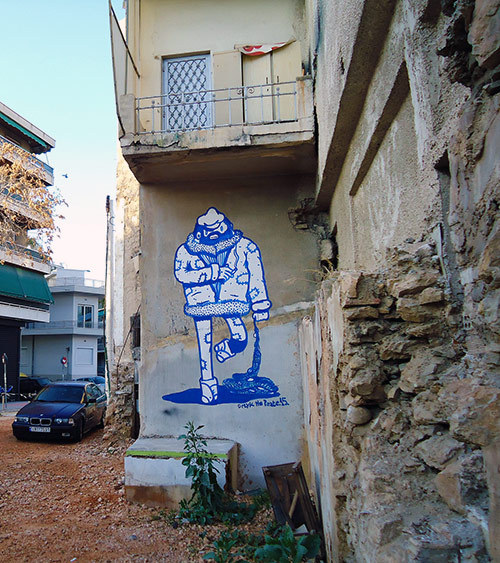
– Can you present yourself? How did it all begin? Did you write letters before painting pirates?
Hello
everyone, i work under the name of Dreyk the Pirate and i’m living in
sunny Athens – Greece, working as a designer / illustrator mostly on magazines. It all begun in the late 90’s, with a couple of friends when I started spraying my crew’s name “BTS”. I was always the one from the crew, who drew a character beside BTS. My characters were kinda “comic-realistic” style so after a while i was bored of making shades. My Graphic Design studies and stuff through magazines, books and ekosystem.org, influenced me and in 2004 I started drawing in streets a navy motif. Boats, mermaids, squids, pirates, anything from sea imaginary.
The last years I was using mostly blue and white but since the beginning of 2016, orange replaced blue.
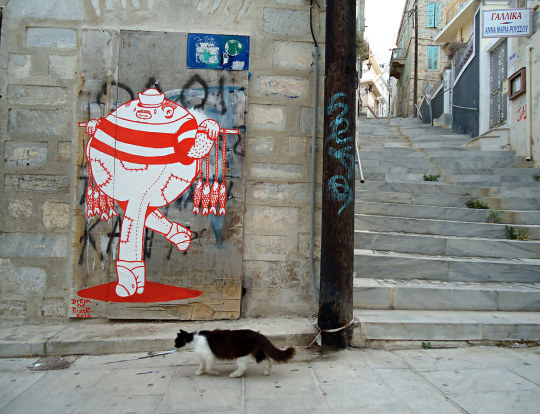
– Your characters look more like fishermen or very nice pirates than actual dangerous pirates. What attracts you to pirates ?
I draw mostly fat sailors nowadays and yeah, they look pretty far from dangerous. Actually, everything i draw looks childish and cute.
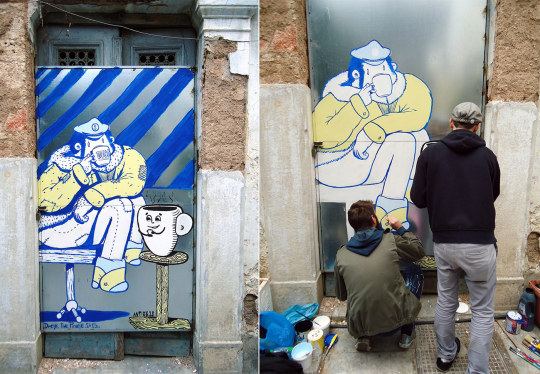
Dreyk the Pirate and
Antios
– You painted lately with Antios. Do you enjoy painting with other artists?
Of course, i always enjoy painting with friends and other artists.
– You paint most of the time in abandoned house in broad daylight in
Athens streets. Is Athens as open as it seems to street painting?
Well, that’s the thing about Athens… Athens is full with old abandoned houses, and i prefer that because (almost) no one gives a shit. Also I love the textures of old walls. So, the reason i prefer doing it in broad daylight, is that i love connecting with the people passing by or coming close to see what I’m painting. It makes me feel great seeing smiles on their faces. I believe, a walk through the center of Athens will convince everybody how open it is.
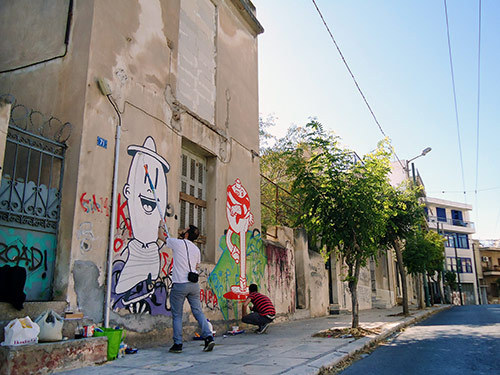
–
You used to paint with spraycans, but on your more recent works you use brushes. What are your preferred tool ? And do you have the feeling people are less “scared” when they see people with brushes than with spraycans ?
Yes, let’s say, for Greek people is less “scary” if they see someone painting in streets with brushes and rollers. They have a “thing” when they see spraycans, plus, emulsion paint is much cheaper than spraycans.
– Which artists from Athens you like or could point out?
I could say my favorite by far is Vasilis Markosian a.k.a. IMPE.
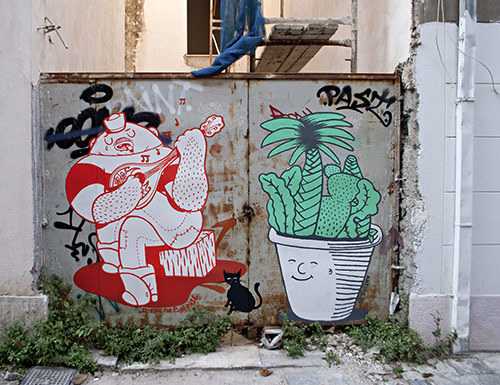
Dreyk the Pirate and Antios
– If you could explore and paint anywhere in the world, where would you go and why?
Every place in the world has its magic, but if i have to choose then it would be Asian countries.
– What do you do when you’re not painting?
I love drinking cold coffee with my girl, watching lots of movies indoors, listening music, and playing with my black cat.
The Toaster interview
When did you start the Toaster project? Is the Toaster a collective or a single person?
Myself and two others started the Toaster project on New Years Eve, 1998. We put our first stickers up the next day, January 1st 1999.
For the last 2 years it’s been just me doing it. It was a naturally progression as I was always the one doing most of the painting and art anyway. We were all cool with the decision.

Did you write letters before starting the Toaster project?
I wrote ‘traditional’ graffiti from 1985 when I was a young kid. I watched the film Style Wars and saw the book Subway Art and it essentially changed my life overnight. I carried on painting graffiti until 1997 but gradually I was deciding I wanted a change of direction. I still loved getting up but wanted to be more conceptual and to stimulate more questions from the public as well as other writers.
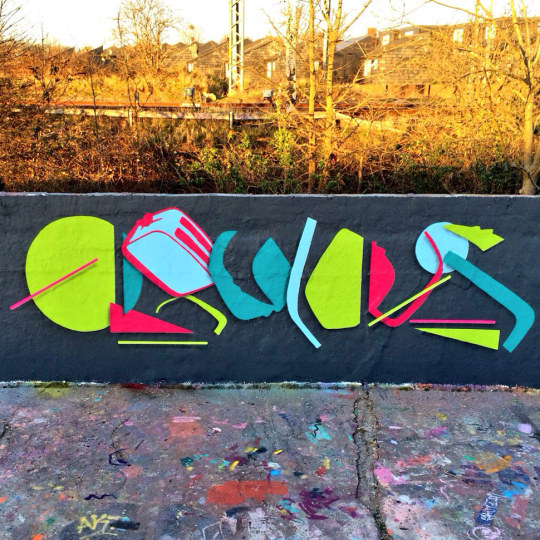
What keeps you still painting? Can you ever feel tired of the Toaster project? Do you see yourself still doing it in 5 or 10 years?
I’ve honestly never got bored of the Toaster image I paint. Rather than it being restrictive painting the same thing I found the initial repetition quite satisfying. Once the image was up in many cities across the world and people knew about it, there was a natural progression for me to deconstruct it and paint pieces with abstracted elements of the Toaster. People still see the Toaster within these pieces but it’s also a way of me going full circle back to my graffiti roots. I’m painting walls that feel like graffiti pieces, with shadow, bold colours, graphic lines and shapes forming letters but it’s all done with me using parts of the Toaster.
I’ve got plenty of ideas to push these pieces further, to go more complex or strip them back to be more minimal so yes I’ll defiantly be painting the Toaster in 20 years let alone 5 or 10 years! I’ve been doing it for 17 years already so why not.
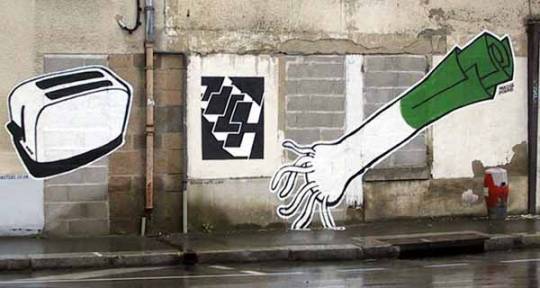
You painted several times with Zime from Eindhoven. Do you frequently collaborate with other artists?
I try and find a balance between painting in isolation and painting collaborative walls. You can learn a lot from both. I often take an element of my last wall and inject it into my next wall. It’s a natural timeline and progression. I’ve painted with Zime a lot the last 10 years. Firstly he’s a good friend but I also respect him as an artist. He’s very precise in his technique. He also likes using only 2 or 3 colours and I enjoy having to adapt my piece to complement his. I’ve also painted walls with Will Barras, Sektie, Space3, Erosie and Roa to name but a few. Also we organised a big Toaster show in London in 2009 with 15 artists. Each painted a Toaster collaboration piece with me and the other Toaster guys. That was sweet.
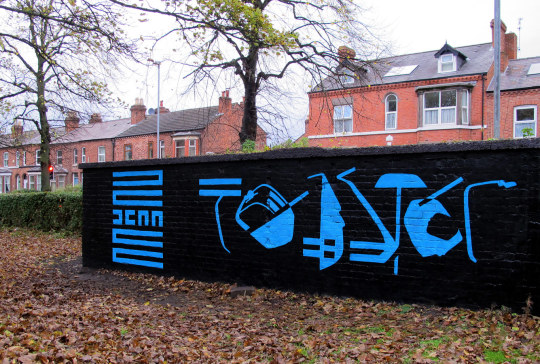
In the early 00’s in France there was someone named “Krisprolls” who also painted toasters. Do you know him or his work? What is the deal with Toasters?
I don’t know the Krisprolls guy personally but yes I saw his work years ago. Sometimes people would email me asking if it was me but I only paint the one type of Toaster!
When us 3 guys started the Toaster project it’s wasn’t because we were really obsessed with an electrical toaster! We simply wanted an image to get up on the streets. It had to be already recognizable so the public asked ‘why?’ not ‘what is it?’. Also we thought it would be cryptic to put the image of a household object on the streets. It would seem slightly bizarre and get folks asking questions. Finally we choose the Toaster image as an insular concept. Like I said at the start of the interview we came up with it on New Years Eve 1998. We were at a house party but as ever we found ourselves away from the main party. We always hung out in the kitchen. Yes it is where the fridge is which means we are nearer the beer, but also we didn’t fit in so much with the main party. We wanted to talk about graffiti in the kitchen while others wanted to dance in the living room. So we thought ‘let’s choose a kitchen object to represent us’! I loved the idea then and love still getting it out there nearly two decades later.

Muretz interview
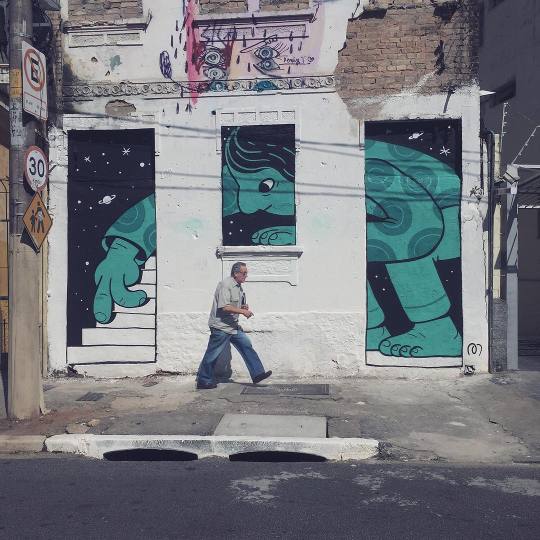
Can you present yourself? How did it all begin Muretz?
I am from Sao Paulo, Brazil, and I’ve been working as an artist for many years, here and in the UK mainly. I am quite new to graffiti, been painting for about 3 years only. I began doing it just for fun, and seeing the reaction from people to my work got me addicted to it. I like to express myself with my art and found in graffiti a great way of doing so.
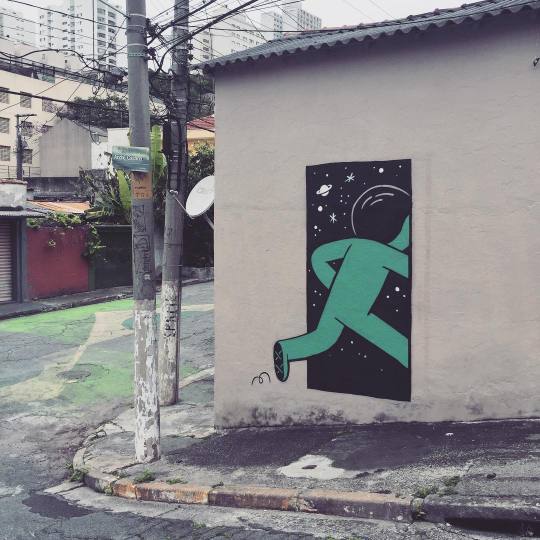
You live in Sao Paulo, you work doesn’t seem to be influenced by the vivid local scene. Could you tell us what are you main influences?
Well I think the local scene is mainly about tagging and putting an art piece out there just for the fun or beauty of it. But I always thought street art is about communication, sending a message to the people out there and few local artists do that in their work, so I decided taking that path. My influences are mainly outside of the graffiti world, they go back to when I was a children’s book illustrator. I am also a big fan of TV cartoons, so a lot of my inspiration comes from that I suppose.
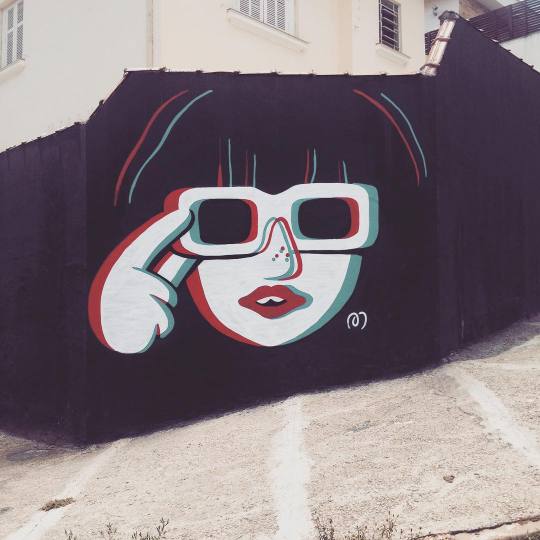
One of your iconic image is the red and blue 3D glasses. Do you have a childhood memory of these glasses like a 3D movie maybe?
I keep a pair of those glasses at home as a decoration piece and one day I thought about doing something about it. I thought it would be interesting to put it out there and have done a few versions of it. People seem to have fun with that so yeah, I guess its one of my favourites.
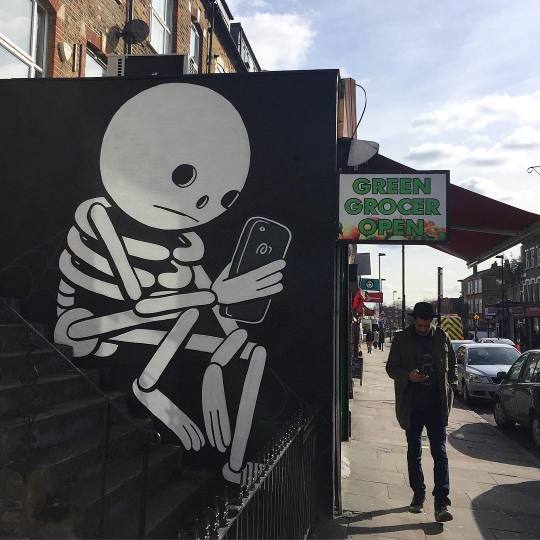
If you could explore and paint anywhere in the world, where would you go and why?
I want to go to the Middle East. I have never been there but I know it would be a great place to spread my art.

Noneck interview:”from Czech Republic to Indonesia”
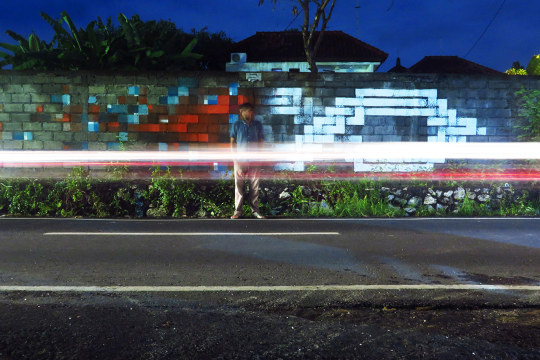
Can you introduce yourself ? Where do you come from?
I come from the Czech Republic but I currently live in Indonesia. Yogyakarta is the City where I study indonesian painting and batik at Institut Seni Indonesia. I am a painter based on the esthetics of graphic design which I did more than 10 years long and almost 20 years I deal with graffiti, street art and murals.
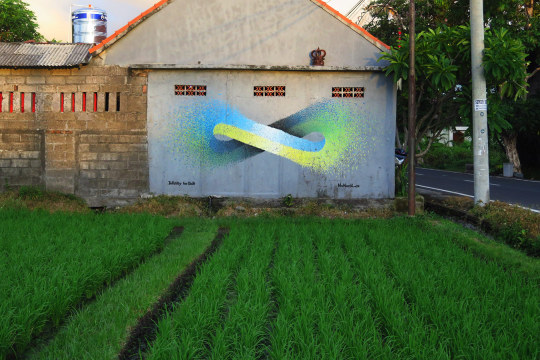
You are now living in Indonesia. Is it a good place to paint ? What are the main differences with painting in Europe?
One of the reasons why I’m here is absolute freedom in street painting. Here there are not something like illegal graffiti because it isn’t considered like an act of vandalism. Local people consider it as an art and the police also has more important things to do such as fining people on the street and standing at waroeng (local fastfood). Art has a long tradition here. Jogja is a cultural
and artistic center of Java, if not the whole of Indonesia. Another advantage is the wild urbanist of Asian cities and Jogja is one of them. There are many places for painting like narrow streets and abandoned houses. But in the other hand i have to be more patient because of Tropical climate with strong sun and high humidity, which makes it very difficult to paint during midday and afternoon. Everything takes more time.

Is there a local graffiti scene or are graffiti only made by strangers?
I was surprised by the size of the local scene and its diversity and the proof is there are eight graffiti shops in the city. In the city it is also possible to meet world-famous names of graffiti and street art.
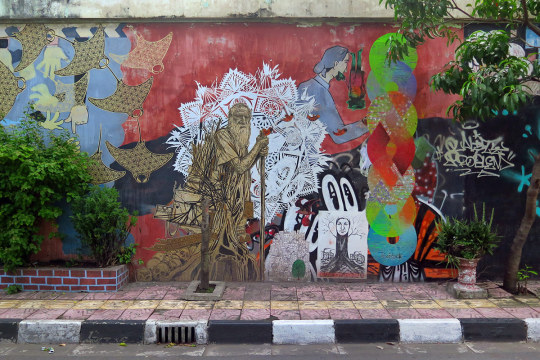
How would you describe your style? What are your artistic influences?
My work is basically abstract. I used to paint and deform letter but at the moment I fall in love with number eight which is also the symbol of infinity in a horizontal position. This describes my relationship to painting; infinity work,
infinity satisfaction, infinity adventure etc…
I am inspired by contemporary grafffuture movements and the work of a lot of abstract muralist like Momo, Hense and many others.
I am also inspired by the Poland scene and by my colleague LUDEK aka KEIM who stays at home with his family whom i collaborate with in distance.
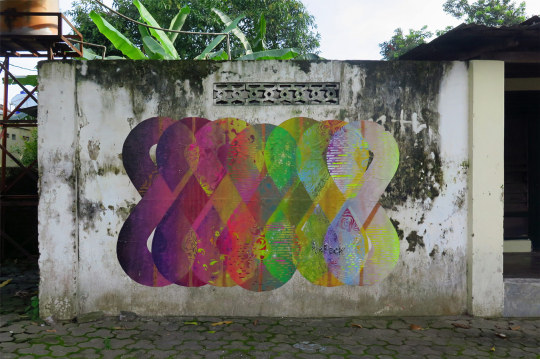
What do you do when you’re not painting?
Travel, travel and travel. There are so many wonderful places that are awaiting to be visited for example volcanoes, temples, waterfalls, beaches, caves and many more. And of course sometimes i have to show my face at the school.
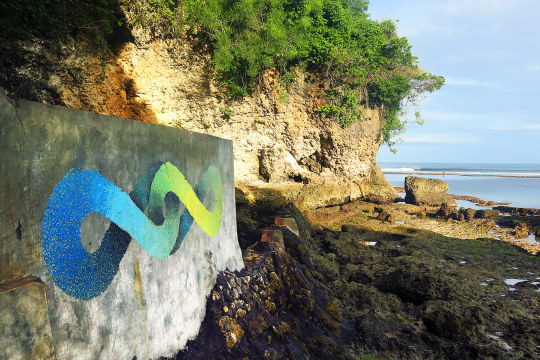
What aspect of Czech Republic do you miss the most in Indonesia?
Things work in a different way and pace here. I have to be extra patient when i want to buy something, fix, manage, or even dealing with bureaucracy.
Sometimes the Indonesian exaggerated politeness combined with laziness and special logic can turn into hell on earth.
And last thing that I miss are good beer and fine wine. Indonesia is an Islamic country that is why it is difficult to get a good quality alcohol.
Lot of things which I don’t miss me more than that i miss.
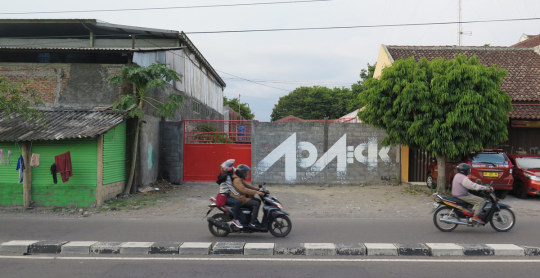
Finsta – Interview + Wallpaper

Interview of Finsta on vltramarine.ru (formerly codered). Short one in English & fully illustrated one in Russian.
Wallpaper of Finsta illustration above: 1280×800 – 1366×768 – 1680×1050 – 1920×1080.
HENDRIK ECB BEIKIRCH Interview + Book preview
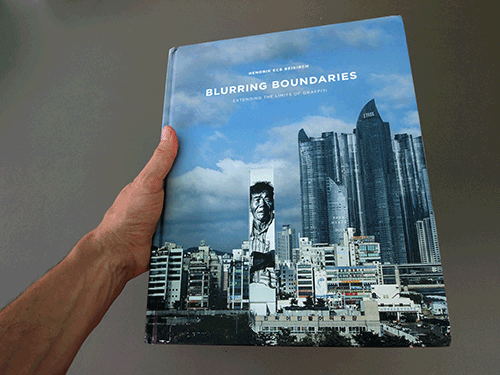
Can you present yourself? What initially brought you to graffiti? And when did you make the transition to painting portraits?
Hendrik ecb Beikirch, traveling the world. Currently living and working in Koblenz, Germany.
I started in 1989 with classical graffiti, but within a short while changed to more of a unique approach.
Back then my concepts where more focused on graphical shapes whereas nowadays the ideas of my work have more of a fine art approach focusing on textures, showing expression within my portraits through a more painterly means rather than just using spray.
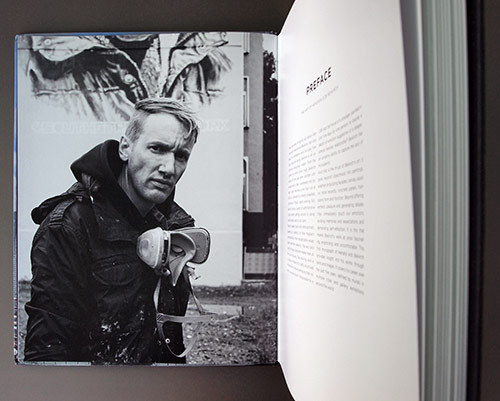
Who are the people you paint?
In both my large-scale murals and canvases, I want to paint people whose faces tell a story; therefore I take inspiration from accidental and brief encounters.
Taking life back to the streets. Real expressions, faces with stories to tell.
Digital media has changed the way we see beauty anyway. Most faces we see printed in public like on billboards or ads appear unnatural.
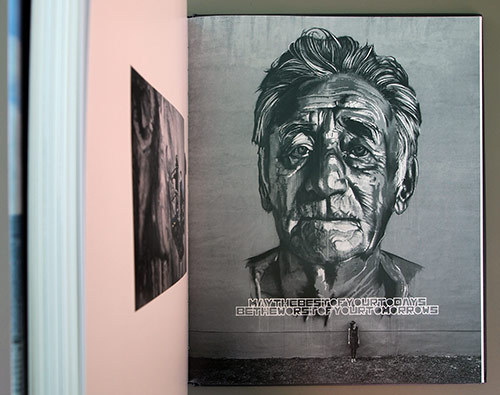
Are your faces always related to the place where you paint them?
The faces are not always related to the place where they are painted.
The portrait has to fit the wall and vice versa, this is a lot about that first feeling.
From a distance, I hope it reads as photo-realistic perfection, yet somewhat unreal due to the drips and abstract textures.
My goal is one should relate so much to the painting from afar, that once he/she stands close, it becomes vague and abstract again.
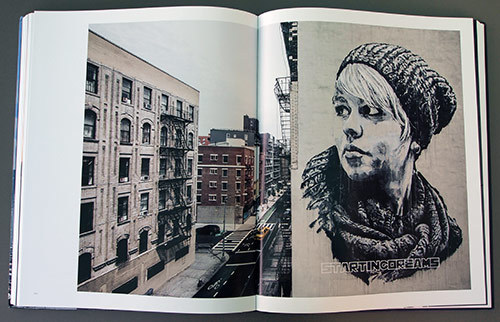
Can you tell us what we will find in your book: Blurring Boundaries ?
documents on 208 pages my achievements of the last years. It captures the two fields I worked on: Fictional faces and portraits of real people, both on walls and on canvas.
Was it difficult to select the photos for the book?
As I do spend a lot of time on the photographic documentation of my woks it was kind of tough to select the best photos.
You’re known for painting large scale paintings. I can imagine it is very satisfying when the work is done. But do you really take fun painting these big walls?
It is what I love to do. In fact painting big walls is relief and fun all at once for me.
When I am in the cherry picker basket – even if I paint quite fast, like doing the side of a 12 story building in three days – a day is less hectic and stressful just like when smoking from a CBD Cartridge.
If it comes to art in public space I believe you got two options to go for: Clandestine, small, hidden and tiny or as big or tall as it can get.
Art has to compete with architecture, advertisements, and passers-by attention in busy city streets.
You only got a few seconds to catch the attention, to get this first impact.
That’s why I go for the bigger the better.

When you have been asked to paint that 70m high wall in South Korea, have you instantly accepted or have you hesitated?
When I first saw a photo of the wall, I was instantly stoked. Arriving at the site it was even better.
The Daniel Libeskind skyscrapers in the background offered a perfect background, both on an aesthetically and content level.
I can imagine you don’t suffer from vertigo… ?
I don’t suffer from vertigo, but as the cherry picker basket was open on the front the view down was something I had to get used to.
Are you sometimes tempted by adding colors to your portraits ?
No, not really.
If it comes to capture emotions in a portrait I think black and white is the best way to go, plus with the big walls you have to break it down to a only a few shades anyway.
And just black and white are so strong by themselves..
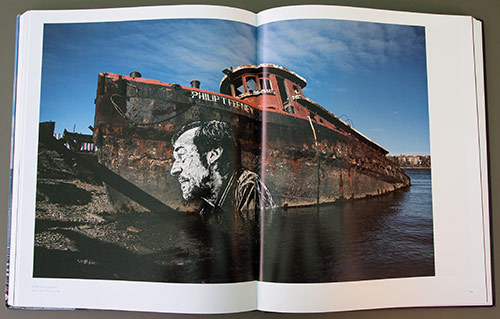
What does inspire you, and who’s work are you into?
My art teacher in school had lived in NYC in the early eighties.
In our drawing room hung a poster he had brought from over there with photos of painted subway cars on it. I was totally fascinated by the Lee Quinones “Stop the Bomb” wholecar.
Besides that the installation Gottfried Helnwein did in Cologne in 1988 in memory of “Kristallnacht” (The Night of Broken Glass 1938). A hundred meter long wall of pictures with large images of children’s faces, in a seemingly endless row. When I saw this back then it blew my mind.
Nowadays Gerhard Richter for his realism and diversity.
Richard Serra for combining art and physical experience as well as for the way he works with public space.
Where do you see yourself in 10 years?
Nothing last forever.
In the end all you have is what you stood for. I am trying to get this right.
BLURRING BOUNDARIES by Hendrik ecb Beikirch
208 full color pages
Publikat Publishing
ISBN: 978-3-939566-32-8
OX interview + installation
Interview with ABIK from Italy
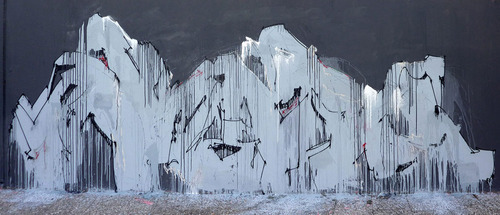
Please, tell me a few words about yourself. When and how did you discover graffiti?
I’m from Italy and I started painting in 1994.
I was just a kid but I already knew graffiti, it really started when someone painted the school facade. That summer I met the authors and I did my first piece.
Twenty years later I’m still a kid.
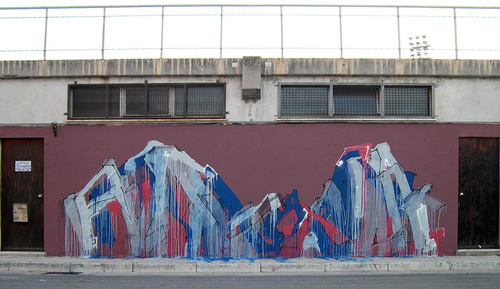
– Your work is going more and more abstract everyday. Do you still have the feeling to write letters? Is the next step to go totally abstract?
– I always begin with writing letters.
My way of doing leads me to consider writing as an act of painting and painting as an act of writing.
I think letters are abstract themselves.
– Some of your latest pieces reminds some works from the fat315 crew from Ukraine. Who or what influenced or inspired you? How did you develop your very personal style ?
– Fat315 crew… I think their style is great. There are a lot of good artist in Europe, lately I enjoyed some works from Eastern Europe and Russia.
Philosophy, literature, cinema, architecture and artists from XX century is what mostly influences me now but at the beginning only a couple of local graffiti writers inspired me deeply… Omaek193 above all.
I have always considered graffiti as chances for changing in general. Sometimes I’ve moved ahead other times I’ve looked back but I always pay attention to the sign. It’s not only about technique: when I let the drips touch the ground or cover other materials, the piece seems to me real and unreal at the same time. I have developed Abik as a parody.
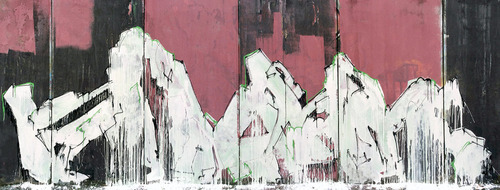
– What are your preferred methods of production and what materials do you like to use?
– During this last few years I have focused on strokes.
Basically I do a first monochrome layer with paint roller. When I paint walls in my town I wait for a few days or weeks before going back to the wall to make a second one. Sometimes I don’t come back at all. I like the fact that every step could work by itself… I want to feel time, for example in winter the weather creates some unexpected effects. I often use sticks to scratch the piece and eventually I add fast outlines… then I rest again…
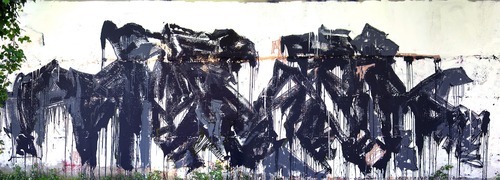
– Which artists from Italy you like or could point out?
– Most of my favourite writers stopped painting at the end of the nineties… recently, I rediscovered some works of Lemon (Milan)… unbelievable.
– Soundtrack to your life right now?
-An evergreen: The Roots – Panic!!!!!
A new entry: Ionio – Talassocrazia
—-

